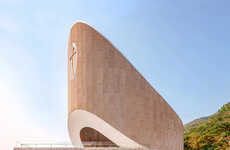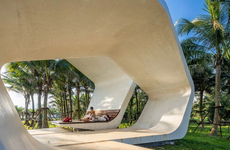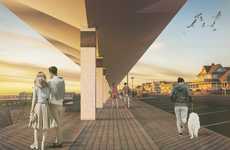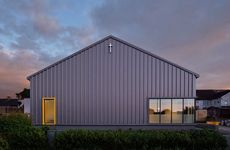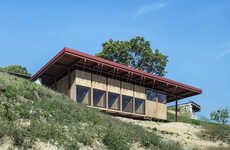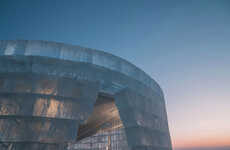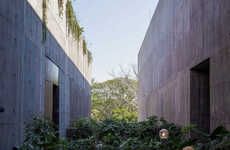
The Design of This Beach Chapel Leaves Space for the Tide to Roll In
Laura McQuarrie — June 24, 2016 — Art & Design
References: vectorarchitects & dezeen
The ever-changing movements of a tide can be both dynamic and destructive, but they do not get in the way of this beach chapel design.
The 'Seashore Chapel' by Vector Architects is now the closest building to the sea in all of Beidaihe, a small town that's just east of Beijing, China. In order to come so close to the sea, the structure was designed to be raised on columns that leave space for the tide to naturally come and go over the course of the day. When the tide is low, a portion of the structure serves as a partial shelter from the surrounding elements.
The creators of the Seashore Chapel remark that "We imagine the Seashore Chapel as an old boat drifting on the ocean a long time ago. The ocean receded through time and left an empty structure behind, which is still lying on the beach." This is a beautiful example of how designers and architects can work alongside nature, rather than disrupt its natural paths.
The 'Seashore Chapel' by Vector Architects is now the closest building to the sea in all of Beidaihe, a small town that's just east of Beijing, China. In order to come so close to the sea, the structure was designed to be raised on columns that leave space for the tide to naturally come and go over the course of the day. When the tide is low, a portion of the structure serves as a partial shelter from the surrounding elements.
The creators of the Seashore Chapel remark that "We imagine the Seashore Chapel as an old boat drifting on the ocean a long time ago. The ocean receded through time and left an empty structure behind, which is still lying on the beach." This is a beautiful example of how designers and architects can work alongside nature, rather than disrupt its natural paths.
Trend Themes
1. Tide-inspired Architecture - Designers and architects are exploring innovative ways to incorporate the natural movements of tide into their building designs.
2. Nature-integrated Structures - Creating structures that coexist harmoniously with nature by leaving space for natural elements, such as tides, to freely interact with the design.
3. Sustainable Coastal Designs - Developing environmentally-conscious structures that minimize disruption to coastal ecosystems while still serving their intended purpose.
Industry Implications
1. Architecture - The architecture industry has an opportunity to rethink traditional building designs and incorporate elements that work in harmony with nature like the Seashore Chapel.
2. Coastal Tourism - Coastal tourism industries can benefit from creating unique attractions, such as tide-integrated chapels, that offer visitors an immersive and nature-focused experience.
3. Sustainable Development - Promoting sustainable development practices in coastal areas by encouraging the construction of eco-friendly structures like the Seashore Chapel.
4.9
Score
Popularity
Activity
Freshness


